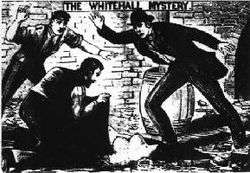Thames Torso Murders of 1887–89
The Thames Torso Murders of 1887–89, often called the Thames Mysteries or the Embankment Murders, was a series of unsolved murders that took place in London in 1887–89. The series included four incidents which were filed as belonging to the same series. None of the cases were solved, and only one of the four victims were identified. Speculations have linked the Thames murder series to that of the contemporary Jack the Ripper series. The murders were given much covering in contemporary press, though they never became as well known as the Ripper murders.
Rainham Mystery
Between May and June 1887, the remains of a woman's body was found in the Thames River Valley village of Rainham. Workers first encountered a bundle with the torso of a female in the river. Throughout May and June, various bodily parts of the same body was found until a complete body, with the exception of head and upper chest, could be reconstructed.
The investigation concluded that the body had not been dissected for medical purpose, but that medical knowledge had been necessary to perform it. Because the doctors could not state a cause of death, the jury was forced to return a verdict of "Found Dead".
Whitehall Mystery

Between 11 September and 28 September 1888, the dismembered remains of a woman were discovered at three different sites in the centre of the city, including the future site of Scotland Yard, the police's headquarters.
The investigation concluded that the dismemberment had been performed by someone with medical knowledge, but could give no cause of death. The jury returned a verdict of "Found Dead".
Elizabeth Jackson
On June 4, 1889, a female torso was found in the Thames at Horsleydown, and more body parts were soon found in the Thames the next week.
The London Times reported on 11 June that the remains found so far "are as follows: Tuesday, left leg and thigh off Battersea, lower part of the abdomen at Horselydown; Thursday, the liver near Nine Elms, upper part of the body in Battersea-Park, neck and shoulders off Battersea; Friday, right foot and part of leg at Wandsworth, left leg and foot at Limehouse; Saturday, left arm and hand at Bankside, buttocks and pelvis off Battersea, right thigh at Chelsea Embankment, yesterday, right arm and hand at Bankside."
The investigation concluded that medical knowledge had been necessary to perform the dismemberment. At the inquest on 17 June, it was stated that: "the division of the parts showed skill and design: not, however, the anatomical skill of a surgeon, but the practical knowledge of a butcher or a knacker. There was a great similarity between the condition, as regarded cutting up, of the remains and that of those found at Rainham, and at the new police building on the Thames Embankment." The London Times of 5 June reported that "in the opinion of the doctors the women had been dead only 48 hours, and the body had been dissected somewhat roughly by a person who must have had some knowledge of the joints of the human body."
The doctors was also this time unable to establish a cause of death. The jury, however, reached the decision of "Wilful murder against some person or persons unknown".
Though the head was never found, the victim was identified as Elizabeth Jackson, a suspected prostitute from Chelsea.
Pinchin Street Torso Murder
On September 10, 1889, Police Constable William Pennett found the torso of a female under a railway arch at Pinchin Street, Whitechapel. The murder remained unsolved.
Speculations
In his 2002 book The Thames Torso Murders of Victorian London, R. Michael Gordon suggests there may be a link to a murder in Paris in 1886, as well as to another murder in London in 1902. In November 1886, a woman's torso was found on the steps of the Montrouge church in Paris, missing the head, legs, right arm, left breast and uterus. In June 1902, a woman's torso was found in Salamanca Alley in Lambeth in London. No suspect was identified in either case.
Fiction
- In the opening scenes of "The King Came Calling", the third episode of the first season of the television series Ripper Street, which takes place in 1889, Edmund Reid (Matthew Macfadyen) conducts an experiment to try and discover where Elizabeth Jackson's remains were dumped into the river; the ambiguity over Jackson's "provenance" leads to a dispute with Reid's opposite number in the City of London Police, who wants jurisdiction over the case.
- The 2013 novel "Mayhem" by Sarah Pinborough is based on the Thames Torso murders and includes newspaper articles from that time. Some of the characters are based on the people involved with the investigation.
References
- R. Michael Gordon, The Thames Torso Murders of Victorian London, McFarland, 2002, ISBN 9780786413485.
- Peter Stubley, 1888 London Murders in the Year of the Ripper, Stroud, 2012, ISBN 9780752465432.
External links
- "The Thames Torso Murders of 1887-89", by Gerard Spicer, at Casebook.org.